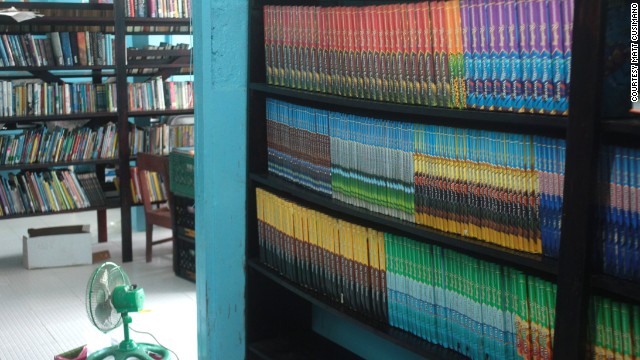It takes a village to build a library
"It's got a lot of rats!" she giggles, burying her face in her hands. They're her favorite part.
Until now, she's never read a book.
She would have had to walk two miles to the closest library before. Now she will won't have to make that long trek, because her village in Guyana built a community library.
"It's something that they wanted for so many years, and they just had no idea how to start," said Matt Cusimano, a Peace Corps volunteer and a teacher at the primary school in Sandvoort, a village of nearly 200 people.
Cusimano has taken on the challenge of creating a library with the villagers.Since starting, he's been working with few resources. Many students are roughly three years behind their expected reading level.
"There's no such thing as literature or fun reads or junior novels or any of those sorts of things," Cusimano said. "They are growing up in an education system of chalk and talk -- where the teacher writes something on the chalkboard and talks about it. They write something on the board (and) the students copy it. There's nothing analytical about it. There's no such thing as differentiated learning."
Cusimano, 25, said it made sense when the school's headmaster approached him with the idea for a communal library.
"Guyana is a performance-based culture, which makes it one of the more appropriate places in this region for a library. ... We are limiting our children's abilities through 'chalk-and-talk' methods of teaching. That's why I was comfortable taking on a library project," Cusimano said.
With a budget of roughly $5,000, the community agreed to front nearly 30% of the costs. But most villagers, Cusimano said, can barely afford toothpaste.
"They're doing it with donated labor and donated space because they can't afford several thousand U.S. dollars," he said.
Some villagers contributed by cooking for hungry workers, while others shelved donated books or painted.
With a daughter in the primary school, carpenter Korth Leitch gave of his time by becoming the construction lead on the project.
"I was just so happy because it's an opportunity that (came) to her, which never (came) to me,"Leitch said.
By day, Leitch, 33, ventured out to neighboring areas building homes and by night returned to work on the library.
"That is where I'm finding this happiness, grateful pleasure for this library because I know my daughter ... my children (are) going to learn a lot from it. They love books."
Leitch said the Bible was the only book he was exposed to while growing up.
lacement=&mr:match=e&mr:adType=slk&mr:referralID=NA&gclid=COzFttLSxrsCFSvl7AodAxYAaA" target="_blank">Better World Books and the nonprofit Margaret Clemons Foundation donated more than 3,600 books to the library. And with three new computers, villagers are anxious to become computer-literate.
"The (people of the) village never had an opportunity to learn about a computer. They never had it. When you are able to read, you're able to work with a computer. If you don't know how to read, you can't start a computer," Leitch said.
In addition to learning about computers, many villagers are discovering new interests.
Ten-year-old Shamar Benjamin comes to the library every night. He gets lost in the fictional battles of "Pokemon" and "Power Rangers." He's encountering words he's never seen before.
"It helps me to read better," he said.
Such opportunities to learn have changed the village of Sandvoort.
Kayla, the 9-year-old girl, now has books to fuel her imagination.
If you want to donate books for the people of Sandvoort, go to their Facebook page for information or to lacement=&mr:match=e&mr:adType=slk&mr:referralID=NA&gclid=COzFttLSxrsCFSvl7AodAxYAaA" target="_blank">Better World Books.
For more ways to help others, go to CNN.com/impact.

 <cite id="galleryCaption001">A library in the Guyana village of Sandvoort was completed in November. With a budget of about $5,000, the community agreed to front nearly 30% of the costs.</cite>
<cite id="galleryCaption001">A library in the Guyana village of Sandvoort was completed in November. With a budget of about $5,000, the community agreed to front nearly 30% of the costs.</cite>